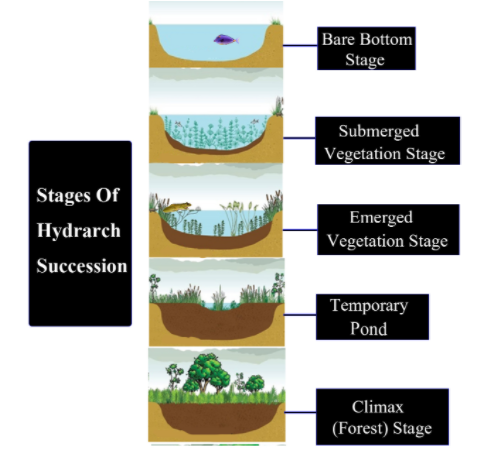
In hydrosere succession, which stage comes just before the sedge meadow stage?
(a)Rooted submerged stage
(b)Phytoplankton stage
(c)Reed swamp stage
(d)Climax stage
Answer
485.1k+ views
1 likes
Hint: An ecological succession is a phenomenon of variation in the species structure of an environmental community by time. The period scale can be of various years, decades, or can be millions of years after extinction in a large amount.
Complete answer:
The hydrosere succession is the succession in which a pond and the surrounding are converted into a land surrounding. In hydrosere succession, the stage comes just before the sedge meadow stage is Reed swamp stage. Reed swamp stage, which is the fourth phase where plants like Saggitaria which have amphibious nature and grow in the shallow water. The Sedge meadow stage follows the Reed swamp stage.
Additional Information: -Plankton stage is the pioneer stage of hydrosere. Various spores reach the water bodies and the organisms that come first are the tiny autotrophic organisms, known as the phytoplanktons. Common examples include diatoms, blue-green algae, and green algae.
-The submerged stage is the second stage. Plants grow roots in the base mud layer and grow thickly. Hydrilla and Vallisneria are submerged plants that are common in this stage.
-The floating stage is the third phase where plants like Nymphaea leave which float and are anchored to the ground and come into the water body.
So, the correct answer is the ‘Reed swamp stage’.
Note: -Sedge or Marsh meadow stage comes after the reed swamp stage, The sedge Carex, buffalo grass, and several small herbs take over the shores.
-Woodland stage is the outer limit of the sedge meadow stage, where the previous organisms are invaded by some leguminous plants.
-Climax Forest is the final phase where the new trees completely take over the area and the smaller tree and shrubs of the previous woodland phase won't exist anymore.

Complete answer:
The hydrosere succession is the succession in which a pond and the surrounding are converted into a land surrounding. In hydrosere succession, the stage comes just before the sedge meadow stage is Reed swamp stage. Reed swamp stage, which is the fourth phase where plants like Saggitaria which have amphibious nature and grow in the shallow water. The Sedge meadow stage follows the Reed swamp stage.
Additional Information: -Plankton stage is the pioneer stage of hydrosere. Various spores reach the water bodies and the organisms that come first are the tiny autotrophic organisms, known as the phytoplanktons. Common examples include diatoms, blue-green algae, and green algae.
-The submerged stage is the second stage. Plants grow roots in the base mud layer and grow thickly. Hydrilla and Vallisneria are submerged plants that are common in this stage.
-The floating stage is the third phase where plants like Nymphaea leave which float and are anchored to the ground and come into the water body.
So, the correct answer is the ‘Reed swamp stage’.
Note: -Sedge or Marsh meadow stage comes after the reed swamp stage, The sedge Carex, buffalo grass, and several small herbs take over the shores.
-Woodland stage is the outer limit of the sedge meadow stage, where the previous organisms are invaded by some leguminous plants.
-Climax Forest is the final phase where the new trees completely take over the area and the smaller tree and shrubs of the previous woodland phase won't exist anymore.

Recently Updated Pages
Master Class 9 General Knowledge: Engaging Questions & Answers for Success

Master Class 9 English: Engaging Questions & Answers for Success

Master Class 9 Science: Engaging Questions & Answers for Success

Master Class 9 Social Science: Engaging Questions & Answers for Success

Master Class 9 Maths: Engaging Questions & Answers for Success

Class 9 Question and Answer - Your Ultimate Solutions Guide

Trending doubts
Give 10 examples of unisexual and bisexual flowers

Draw a labelled sketch of the human eye class 12 physics CBSE

Differentiate between homogeneous and heterogeneous class 12 chemistry CBSE

Differentiate between insitu conservation and exsitu class 12 biology CBSE

What are the major means of transport Explain each class 12 social science CBSE

a Tabulate the differences in the characteristics of class 12 chemistry CBSE




